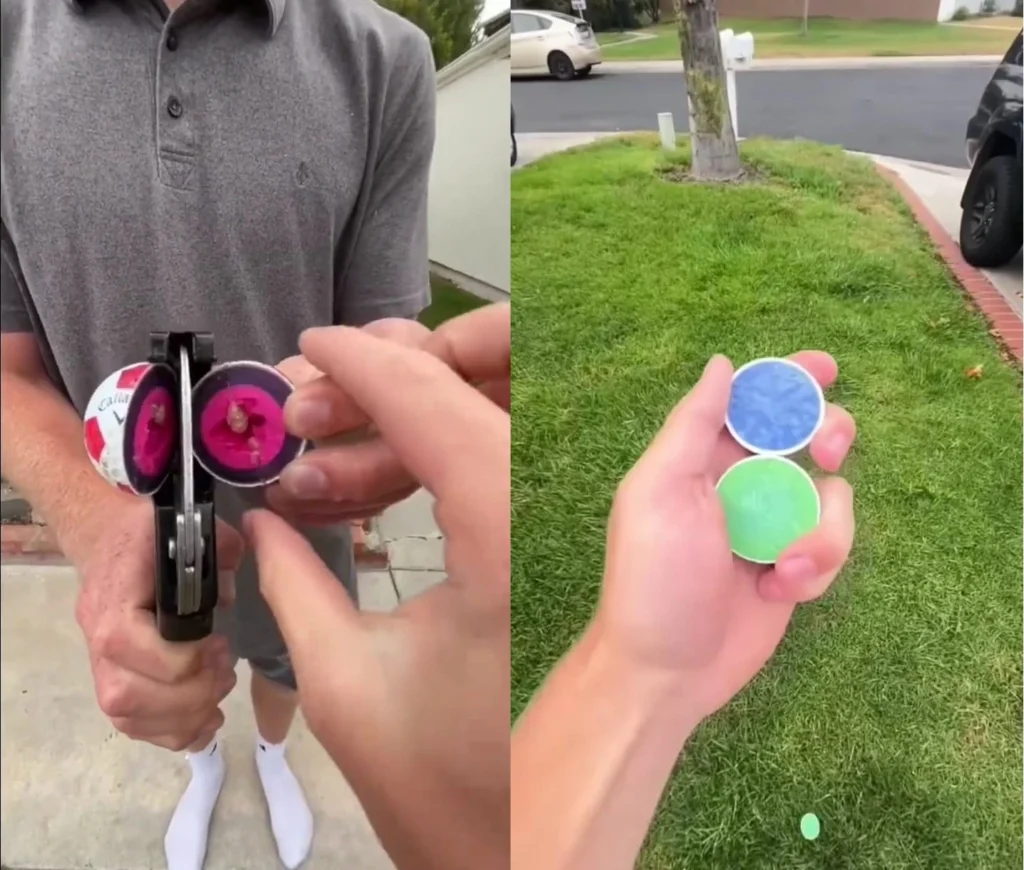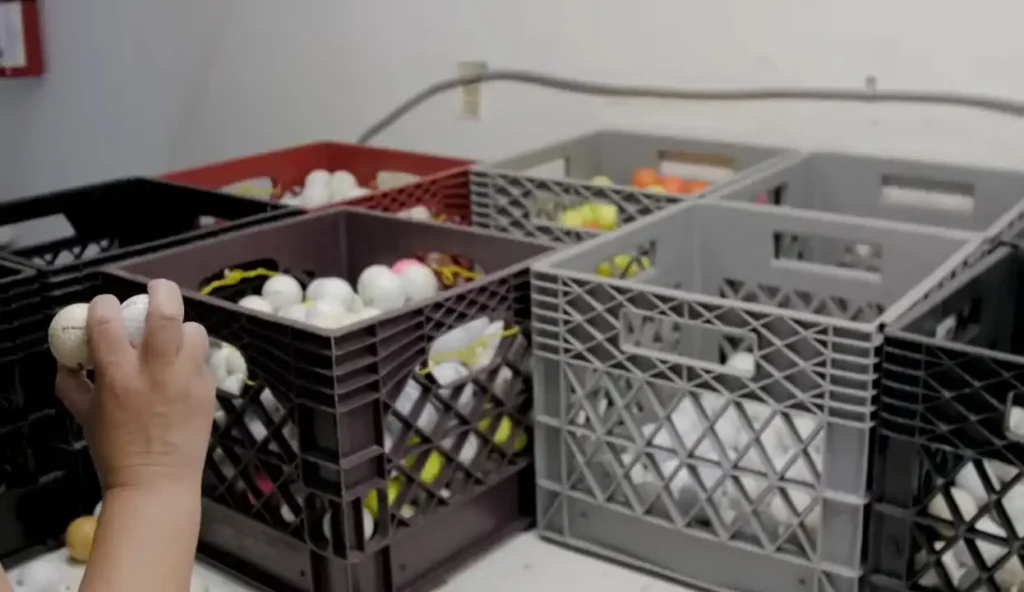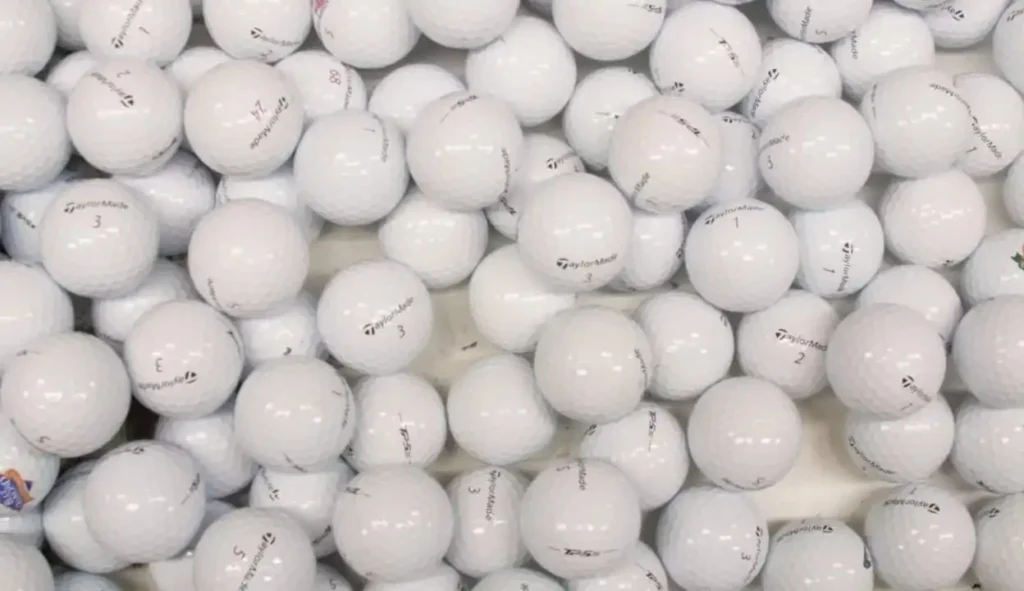It’s not unusual for golf courses to have ponds and lakes (and even black swans roaming around annoying players). Many golfers accidentally manage to hit unimaginably longer shots, throwing their golf balls into the depths of nearby lakes. Among the 300 million golf balls that are either lost or discarded after frequent usage, many are forgotten underwater. These golf balls end up getting waterlogged, especially when they end up in water and divers manage to fish them out after several days. So, do golf balls get waterlogged very easily? How to know if your golf balls are now waterlogged for good? We’ll discuss waterlogged golf balls at length here.

Do Golf Balls Get Waterlogged?
So, do golf balls get waterlogged? Yes, golf balls can get waterlogged, and it can significantly impact their performance. When a golf ball absorbs water, it becomes heavier, loses its balance, and doesn’t travel as far or straight as it should. That’s why waterlogged golf balls are deemed wasted accessories and not suitable to be used in professional golf tournaments.
To determine if a golf ball is waterlogged, you can perform a simple “float test.” Fill a container with water and gently place the golf ball in it. If the ball sinks or floats unevenly with a portion of it submerged, it’s likely waterlogged. We’ll explain this float test in detail soon.
Just remember to keep your golf game at its best by learning how to keep your golf balls dry and in optimal condition. That’s the answer to the question, “Do golf balls get waterlogged easily?” Now, we’ll move on to discuss what to do with waterlogged golf balls.
What to do with waterlogged golf balls?
Don’t know what to do with waterlogged golf balls? Well, they can be reused and converted into lake balls. Lake balls are fished from a golf course lake/pond, cleaned up, and then resold to amateur golfers; these cheap balls are used to practice so greenhorns can fine-tune their skills under a budget. We’ve also written an article on what to do with used/damaged golf balls. So, keep an article on this topic accessible here. But do golf balls get waterlogged and pose a serious ecological hazard? Let’s find out.
Are waterlogged golf balls a hazard?
Golf balls that end up in lakes, ponds, and even big oceans pose a significant threat to the delicate marine environment. For instance, here’s a Medium article showcasing how golf balls are slowly polluting the seas and endangering marine life. So, what happens when you drop a golf ball in water reservoirs? These golf balls pollute those reservoirs and need to be fished out quickly. Many articles discuss which golf courses in the U.S. contribute to more golf balls ending up in the ocean and which PGA Tours have the most number of golf balls in water reservoirs. So, if you end up throwing a golf ball in a pond/lake, make sure to fish it out. As traditional golf balls are made of plastics like polyurethane, they are bad for the environment.
Do golf balls get waterlogged for profit?
Since waterlogged golf balls are quite common on golf courses, divers are hired to stay vigilant and retrieve these balls. These brave individuals dive deep into lakes and ponds (even oceans in some cases) to fish out quality golf balls, especially if it’s owned by a wealthy patron or if it’s made of water-resistant materials and can be saved by a quick rescue. It’s estimated that such divers make from $30,000 to $100,000 working on golf courses. If you’re an experienced diver, consider retrieving waterlogged golf balls as a profession.
How Do Golf Balls Get Waterlogged?
Wrong Shots
Wayward shots are often the root of waterlogged balls. A slight slice or hook could easily send your prized golf ball sailing toward an unsuspecting water hazard and out of play in seconds.
Weather Conditions
Adverse conditions like constant rain or high humidity create the ideal setting for golf balls to absorb moisture quickly, helping the game. That’s why golfers avoid playing in the rain.
Course Conditions
Additionally, course conditions play a part in mishaps during golf games. Wet fairways and soggy greens as well as water hazards all increase your risk of an unfortunate shot into an unexpected spot on the green or fairway.

Signs of a Waterlogged Golf Ball
Weight Disparity
One sign is an increase in weight. Waterlogged golf balls often feel heavier than they should and interfere with fluid swinging action and limited shot reach. Absorbing too much water will make them noticeably bulkier.
Loss of Distance
Do golf balls get waterlogged and fly to shorter distances? Yes, noticing an irregularly decreased shot distance could be the sign that your ball has become waterlogged and weighed down, restricting its capacity for travel at its usual distance.
Control Issues
Waterlogged golf balls can be notoriously hard to manage, leading to unpredictable shots that cause frustration on the course.
Note the Difference in Sound
Try to identify variations in sound quality. A waterlogged golf ball produces a duller tone when struck than that produced by dry balls.
Durability Issues
Constant water exposure to water can affect both the cover and core layers, shortening their lifespan and potentially diminishing performance. So, do golf balls get waterlogged and become less durable? Yes, they do.
Test To Check Waterlogged Golf Balls
Conduct an in-depth visual examination of your golf ball’s surface to search for cracks, cuts, or nicks that might allow water to seep into its core and cause leakage issues. Before moving forward with any tests, conduct a gentle squeeze test using both thumbs. So, do golf ball get waterlogged and show visible signs of waterlogging? Yes, consider these tests:
Squeeze Test
Conduct an easy yet reliable way of conducting a squeeze test. Hold the golf ball between your thumb and fingers and give a soft squeeze with just thumb pressure. Waterlogged golf balls may feel slightly softer due to moisture trapped within. So, can a golf ball get waterlogged and show signs? Yes, you will see it’s damaged upon squeezing the damn thing.
Float Test
Essentially this method takes several minutes of work but delivers accurate results quickly. So, fill a bucket with water and submerge a golf ball, taking care to fill it up to the surface of the bucket. Now drop a suspected golf ball into the water. If it immediately sinks to the bottom, it will indicate waterlogging damage. If it floats at its surface and remains undamaged by it you don’t have a waterlogged golf ball.
Spin Test
Spin test results may also indicate waterlogging. Set the ball on an even and smooth surface. Now give it a gentle spin using only your fingertips. If the ball wobbles or deviates off-course during its spin, that could be an indication that waterlogging has occurred; additional weight from moisture could disrupt balance and reduce the performance of the ball.
How To Deal With Waterlogged Golf Balls?
Stay Calm
Do golf balls get waterlogged very often? Yes, however, after seeing your golf ball make an unexpected dive into the water, you must maintain your composure and remain composed. Let a diver go and look for these lost golf balls later.
Evaluate Your Situation
Before making any moves, assess the water hazard first by taking note of its depth and whether retrieval could compromise your position or incur extra penalties. If it appears shallow enough, retrieval might even be worth exploring further.
Select an Appropriate Club
When playing from water, carefully choose the club that best satisfies the shot you intend on taking. A lofted club may help lift the ball from beneath it to get you back onto course quickly and in control. So, do golf balls get waterlogged very often? Not if you have a trusted club layin’ around!
Employ Retrieval Tools
Carry retrieval tools such as ball retrievers or extendable ball retrievers with you when playing golf to increase reach, making retrieving submerged golf balls much simpler without venturing too close into the water yourself.
Consider Penalty Drop
In situations when playing from water is too risky or impractical, golf’s rules provide for penalty drops as an alternative solution to ensure that a dry playing line awaits your next shot. Also, sometimes taking this route can help avoid additional complications and save a stroke penalty penalty penalty stroke from accruing.

Tips For Preventing Waterlogged Golf Balls
Store Properly
One key strategy for avoiding waterlogged golf balls is proper storage conditions. Keep them in cool, dry places such as an airtight box to minimize their moisture exposure. Keeping your balls out of humid environments such as wet golf bags can do wonders in keeping their performance intact.
Conduct Regular Inspects
Do golf balls get waterlogged regularly? Well, before every round, take time to thoroughly examine each golf ball closely for signs of damage, wear, or imperfections on its surface. Detecting issues early can help avoid playing compromised balls in play.
Invest in Quality
Make an investment in high-quality golf balls made of materials less likely to absorb moisture. Although they may come at a slightly higher cost initially, their durability and performance benefits over the longer haul justify this additional expenditure.
Change When Necessary
If a golf ball becomes waterlogged, do not hesitate to switch it out with another dry one immediately. Playing with compromised balls could adversely impact both shots and overall game performance, and replacing it is worth investing a small sum in for optimal playability.
Conclusion
So, do golf balls get waterlogged very easily? Golf balls can absorb water after spending a long time underwater. Waterlogged golf balls are no friend to any golfer, as they can result in poor distance, accuracy, and control. Hence, keeping your golf balls in top condition is essential for maintaining your performance. By understanding the signs of waterlogging and taking preventive measures like drying wet balls promptly and storing them in a cool, dry place, you can ensure that your golf balls remain in the best possible shape.
FAQs – Do Golf Balls Get Waterlogged?
What causes golf balls to become waterlogged?
Golf balls can absorb water if they land in water hazards like ponds, lakes, or rivers. Also, storing golf balls in damp environments like garages or basements can cause them to absorb moisture and become waterlogged. If you soak golf balls in water for long periods, after 12 hours in water, the outermost layer of the ball allows water to enter.
How does water affect the performance of a golf ball?
Water can harden the core of a golf ball, which can affect the ball’s performance. Water can also cause up to 30 yards of distance loss from driving shots. It decreased the ball’s compression and friction upon impact, which can make for less satisfying returns. Moisture can lead to a drop in backspin, which can cause a rise in carry. Submerging a golf ball in water can permanently affect its performance.
Can water damage a golf ball permanently?
Yes, water can permanently damage a golf ball. Submerging golf balls in water for extended periods can cause them to absorb water and affect their performance.
Are some golf balls more resistant to waterlogging than others?
High-quality dimpled spheres are designed to resist water absorption and maintain their performance characteristics. However, there are some factors that can affect how much water a golf ball absorbs, including ball type, cover material, water temperature, and submerged time.
How can I prevent my golf balls from getting waterlogged?
Use a waterproof bag to golf balls from getting wet. Avoid storing golf balls in damp or humid areas, as moisture can cause them to deteriorate or become moldy. Carry a towel to dry your golf ball if it gets wet during play. That’s how you can prevent your precious orbs from getting waterlogged.
Can a golf ball get waterlogged easily?
Yes, golf balls do have the capacity to become waterlogged when in contact with water. When exposed to water for a long time, they can slowly absorb the liquid into their system which could eventually compromise performance. While some golf balls get waterlogged in just a few hours, others may survive underwater for as long as 12 days.
How to know I have waterlogged golf balls?
Fill a container of water deep enough to fully submerge a golf ball and then gently release the golf ball into it. If the golf ball remains floating on top of the surface water for any significant period, that indicates waterlogging, in which case you should retire it from play immediately. Conversely, if a golf ball sinks to its original place on the green, it’s ready for its next swing on the course.
How do I make sure my golf ball is good to go?
To evaluate the quality of a golf ball, start by inspecting its surface for any cracks, nicks, or cuts that could impede performance and conduct water testing to check for waterlogging. That will help make sure that you use balls that help achieve maximum shots on the course. Thus, this comprehensive inspection should help make sure that every shot counts. That’s the end of our blog on, “Do golf balls get waterlogged?”











